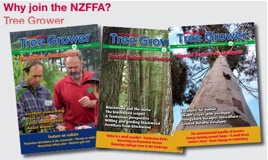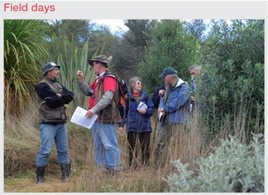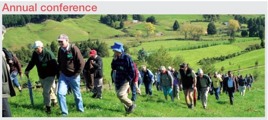Eucalypts in the sand country
Denis Hocking, New Zealand Tree Grower August 2010.
I would not quite say that eucalypts have wound up as my alternative species of choice as a default, but it has been an interesting trip sorting out what good quality, alternative timbers can be grown on my sand country. If you want my honest opinion I think cypresses should be regarded as the most appealing of the alternatives, with well recognised timbers, established processing industry and logs that are readily sawn with radiata pine facilities. But the issue when I set out on my quest was − how did they really perform on my obvious afforestation country, the sand dunes?
When I took over this property in the mid-1970s my father had already established one excellent, and some other very respectable, macrocarpa blocks along with limited eucalypt plantings mainly Eucalyptus botryoides, E. saligna and E. obliqua, but all on the flats, not the dunes. Eucalypts always had appeal because their timbers are so markedly different from radiata pine, including high durability in some cases, but cypresses made sense. That is until, perhaps, you consider the environment and the sites.
Location, geology, soils and climate
The property is located three kilometres from Bulls at the very inland end of the Rangitikei/Manawatu coastal sand country. These are Foxton phase, parabolic sand dunes supposedly 3,000 to 5000 years old – older and higher than the more coastal dunes. The dunes are very susceptible to wind erosion. There is no natural run-off as this is wind formed topography. Instead there is a rising and falling water table. In addition the ground water is iron saturated and highly anaerobic. This means iron-stone structures with some perched water tables.


Soil fertility varies, with some of the old swamp areas being very good, but most of the property is on medium to low fertility, sand soils. Sand dunes make up 40 per cent of the area and their black Foxton sand soils are of low natural fertility, very drought prone, but have few rooting impediments.
There is a limited area of Ohakea soils, which are heavier, loess based silt loams of the terrace that underlies the sand. The topography of the dune country has major effects on the micro-environments. The northern faces are warm, largely frost free, but summer dry with the shady southern faces moister and cooler. These offer quite different environments and there are also numerous frost hollows.
The prevailing west to north west winds are rather saline and blow along the dunes, but it has been the occasional southerly storms that have done most tree damage over the years. Average annual rainfall is a rather erratic 850 to 900 mm with a winter maximum. A run of high winds along with low moisture holding capacity in the soils can mean very dry summers.This could be described as an east coast type environment on the west coast.
Farm statistics
The farm has a total area of 247 hectares, with 112 hectares forested with around 70 per cent in radiata pine. The flats are used for a sheep and beef cattle breeding operation. The plantations are grazed, mainly with cows in the autumn.
History
There has been a long history of tree planting on this property, dating back to the late 19th century, of radiata pine, macrocarpa, Pinus pinaster and E. globulus. Early plantings were mainly for soil conservation, but interestingly a macrocarpa plantation was established in the 1920s or 1930s. After the family bought the property in 1955, my father, with his Forest Service experience, oversaw a more systematic afforestation programme, mainly radiata on the dunes, but also the macrocarpa and eucalypts mentioned earlier, with the inevitable dendrological indulgences.
When I took over in 1975, 30 hectares was in trees, most of which was radiata, generally well managed. I continued the policy of planting the dunes, but was keen to break away from the radiata monoculture. But what else would perform on the dunes?
The answer seems to be a lot more than most people believed and more than I expected, but not necessarily what was recommended. It soon became obvious that macrocarpa and other cypresses would only perform on the flats or lower, south facing dune slopes. In addition, cypress canker was a conspicuous problem. Nor were E. botryoides and E. saligna stand out performers on most of the dunes.
I searched through the published wisdom of Forest Service and FRI literature and in hindsight I can only say that it held me back several years. Advice from more experienced farm foresters, along with trial and much error along with enthusiastic assistance and supported from local Forest Service extension officer, the late Ross Jamieson, proved more successful. In retrospect, and with the help of the Australian literature, it is easy to rationalise what emerged. In particular I would refer people to R G Florence’s The Ecology and Silviculture of Eucalypt Forests.
Eucalypts to the fore
Things really took off in 1980 when I found a nurseryman, Murray Faulkner, growing a wide range of eucalypts. Were there eucalypt species that would thrive on the sand dunes and produce good quality timber? Durability was another consideration.
The answer was a resounding yes. A number of species proved well suited for the sites, but in particular the stringybark eucalypts really thrived and these species are renowned for the quality, and durability of their timbers.
It quickly became obvious that the Moncalyptus eucalypts − the ashes, stringybarks, peppermints and a few other odds and ends − handled the low fertility dune sites much better than the more fertility demanding species such as E. botryoides, E. saligna, and E. nitens. However, the monocalypts, especially E. pilularis, have, unexpectedly, proved more drought susceptible, something that has been noted elsewhere in New Zealand.
Today, E. muelleriana is my preferred species on the north facing dune slopes, with E. globoidea, E. laevopinea, E. pilularis, and E. microcorys also rating. On the colder flats and perhaps on southern dune slopes, E. fastigata appears to be the eucalypt of choice. Some experimentation is continuing with other stringybarks and a number of species listed below. In the hope that I can speed up the travails of some of our younger members, here is a very brief summary of my experiences to date with different timber eucalypts.
Stringybark eucalypts
These are my first choice. They are monocalypt eucalypts renowned for ease of saw milling, with minimal growth stresses, drying and processing, with good timber properties including moderate to good durability. Monocalypts generally have relatively few insect pests, seem to tolerate exposed sites and will handle lower fertility soils, but need good drainage. The following list is roughly my order of preference.
E. muelleriana Shows excellent growth rates matching radiata pine, form and health on northern dune slopes. One of the easiest milling and processing eucalypts with excellent timber properties. Rather frost tender and needs free draining soils, but handles low fertility sites. It is my first choice on northern dune slopes. The 2003 drought did kill a few trees. In recent years I have used my own seedlot as first choice. They are rated Class 3 for durability in Australia, but anecdotal information in New Zealand seems to rate it higher.
E. pilularis Blackbutt, a common timber species of coastal NSW and a common hardwood power pole. Not really a stringybark but very similar to E. muelleriana. Not quite as fast, somewhat poorer form and has proved more susceptible to drought on the sand dunes. In its natural range rainfall is 1,000 mm or more, generally with a summer maximum. It has a Class 2 durability.
E. globoidea Another well known stringybark with good wood properties and minimal pest problems, but has not performed as well as E. muelleriana on my dunes. Rated Class 3 for durability in Australia but anecdotal information here suggests it is more durable.
E. laevopinea Impressive performance on two sites here, but seems to show more response to declining fertility and moisture as you move up the dune. They are relatively frost tolerant, with a good reputation in Australia, but little experience in New Zealand.
E. agglomerata Limited plantings around New Zealand and not as impressive as the above species, with a Class 2 or Class 3 for durability.
E. youmanii Has a reputation for good frost tolerance, but the few plantings here at slope bottoms have been very slow.
E. baxterii Has not been a success here, with very poor form, but may just reflect this Mt Gambier seedlot.
All the above species and more are in the recent stringybark trials.

E. microcorys This is in a subgenus of its own, Nothocalyptus. It is slower than the stringybarks, very frost tender, but grows steadily on northern dune slopes with good form and excellent health. It is possibly the best eucalypt timber being grown here and mills very well even in small logs. It is rated Class 1 durability in Australia, but generally New Zealand grown wood is Class 2.
I have posts that have been in the ground for around ten years with minimal decay. I would rate it as the best all round high durability and sawn timber eucalypt, but loses out on growth rate.
Ash group eucalypts
These are amongst the most common species grown in New Zealand, suited to cooler wetter climates. They are more difficult to saw and process than the stringybarks and the timbers are generally inferior, with none rated as durable. Like the stringybarks, ashes seem to tolerate lower fertility and exposed sites but as a rule need free draining soils. They have few insect pests.
In rough order of preference −
E. fastigata Although one of the standard milling species of New Zealand, I have done rather little with it to date. A planting in 2000 on a site that would be too cold for most stringybarks is doing well. E. fastigata is relatively frost hardy and has been widely, and very successfully, grown around the country. It is regarded as the best milling ash eucalypt producing good quality, blond timber.
E. obliqua They are similar to fastigata and limited plantings here have performed quite well, but they proved somewhat drought sensitive. Older trees harvested recently milled well, but with quite a bit of kino, a feature of the species. They have grown very well elsewhere in this region and in eastern North Island and northern South Island.
E. fraxinoides Have looked good on the dunes, until suspected root diseases started a random slaughter at around 20 years. I understand it mills well and is quite a common shelterbelt species.
E. regnans At best they are very impressive trees but inferior timber compared to the above due to growth stresses and collapse. Apart from some trees on a southern dune slope, they have not performed very well here.
E. delegatensis A very frost tolerant species which I have not bothered with for 30 years.
E. oreades They have grown well but E. andrewsii, a good milling species in Australia has been a notable failure.

Eastern blue gums
With their superb red timbers these species were much favoured up till the 1980s, but insect pests have severely dented their reputations in recent years. They tend to be difficult to saw due to growth stresses, but dry and process very well.
E. botryoides Much favoured for salt and wind tolerance as well as the timber, but have been the most severely affected by insect pests, especially the Ophilemus gall wasp and Cardiaspina lerp. Some individual trees seem to tolerate pests much better than others.They need reasonable fertility and struggle to get to adequate size on the dunes.They are often poor form and break up in severe winds.
E. saligna These are closely related to E. botryoides but seem to be somewhat less affected by insect pests. They need more fertile sites and some shelter from saline westerly winds. The timber is superb timber, but can be difficult to mill..
E. deanei and E. robusta These are two other species from this group that are doing reasonably well here and appear less affected by insect pests. The growth rates still well behind stringybarks, but E. robusta will grow in swampy conditions.
Other eucalypts
Corymbia maculata These were formerly E. maculata, and are another very good timber species, but struggle on the dunes. More recent plantings on cut-over sites rather than grazed dunes look much better. Could this be a a mycorrhizal fungi problem? The wood is Class 2 durability.
E. cladocalyx These are extremely drought tolerant with no apparent insect pest problems, but somewhat frost tender. They show remarkable height growth, but are reluctant to stand up straight. They have a high percentage of heartwood and a couple of trees milled recently behaved very well, though the wood is extremely hard. They have Class 1 durability.
E. bosistoana A frost tolerant species that handles seasonally wet sites. They have shown good form and reasonable growth rates on wetter, heavier soils, with Class 1 durability.
E. cornuta Two different seedlots have given very different results. The better lot have shown good growth and adequate form on an exposed dune top. The poorer seedlot showed adequate growth rates, but in all directions. They have Class 1 to Class 2 durability.
E. patens Have shown reasonable growth, but often suspect form although they produce good timber.
E. propinqua These are attractive trees but seem to need higher fertility sites. They are Class 1 durability.
E. argophloia A rare, but highly regarded species in Australia that has recently gained some interest in New Zealand. Some 11 year old specimens here have quite good form but are slow growing and probably needs better soils. They are Class 1 durability.
E. cloeziana A very good plantation species in more tropical climates, though probably not suited to these soils and environment. They are also relatively slow growing but have very good form here and are Class 1 durability.
E. jacksonii This is an interesting species, being along with jarrah, one of only two red timbered, monocalypt eucalypts. As already mentioned monocalypt species seem to have a far lower insect pest risk, and in their natural forests are reported to have few serious pests. They have very high quality timber and grow to very large trees, but occur only in a very small area in southernmost West Australia, virtually all in national parks. It would seem well suited to New Zealand conditions, but preferably on better soils than I can offer. Growth rate here is modest and form is quite acceptable. I think this species warrants further attention in New Zealand as a high quality, red eucalypt timber.
E. brevistylis A rare, West Australian species that occurs in association with E. jacksonii. Not much is known, least of all by me, but the growth rate is acceptable and form is good.
Other Class 1 and Class 2 durability timbers that have performed more modestly are E. camaldulensis, E. guilfoylei, E. gummifera, E. longifolia, E. melliodora, E. quadrangulata,
E. gomphocephala, E. guilfoylei, C. gummifera, E. sideroxylon, E. umbra, while E. crebra, E. moluccana, E. paniculata, E. polyanthemos and E. teretecornis have hardly performed at all.
Eucalypt establishment and silviculture
Virtually all eucalypts have been container grown, mainly root trainer. I normally planted them in alternate rows between radiata pine − four metres between rows, eight metres between eucalypt rows − in mid to late September the year after the pines. By running the rows up the dune you can get a good idea, from relative growth up the slope, of a response to fertility, moisture and frost.
Two or three slow release fertilizer tablets should be included at planting and then a couple of months later the seedlings should be spray released, very carefully under calm conditions, with glyphosate (Roundup). Pre-emergence, residual sprays, such as the triazine chemicals used for radiata pine, cannot be used round hardwoods on these low organic, sandy soils.
Eucalypt pruning is a relatively easy job, except perhaps removing double leaders. I always do it in dry conditions during mid to late summer to minimise the risk of silver leaf infection. Stringybarks and many other eucalypts will naturally shed smaller branches.
I advocate enthusiastic thinning and somewhat longer rotations for larger diameter logs, but others see things differently. All my better performers have been successfully milled at 20 to 25 years of age.

 Farm Forestry New Zealand
Farm Forestry New Zealand

